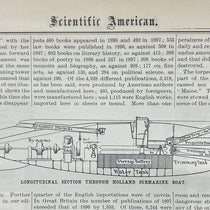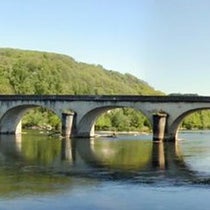Scientist of the Day - James Brindley
James Brindley, a British civil engineer, died Sep. 27, 1772, at about age 56. Brindley was trained as a millwright's apprentice and had no formal education whatsoever – he did not even know how to read. Yet when the Duke of Bridgewater wanted to build a canal, from his coal mines in Worsley to the industrial section of Manchester, it was Brindley who was tapped for the job, because he had a reputation as a true mechanical genius. And it is not as if the Duke had his choice of canal engineers, since there were no canals at all in England when he conceived his idea.
The biggest problem was not digging the canal but figuring out how to get the coal from the mines into the canal boats. The Duke, Brindley, and the Duke’s engineering advisor, John Gilbert, decided to take the boats right to the coal seams via a network of canal tunnels. Because the tunnels were very narrow, the boats had to be narrow, and also very long, if they were to carry a respectable load. So Brindley’s canal boats were 70 feet long and 7 feet wide, and these “narrowboats” would become the standard canal boats for a very long time. A 19th-century painting shows a narrowboat making its way along the Bridgewater canal (first image)
The first stage of the Bridgewater canal, from Worsley to Manchester, was completed in 1761. In the map above (third image), the original canal is at upper right; the extensions to Runcorn at bottom left and Leigh at top center were added a few years later. Brindley's greatest innovation was the Barton aqueduct, which carried the canal over the river Irwell, and which all the educated engineers said was impossible – who ever heard of shunting a canal over a river! Many paintings of the aqueduct have been made over the years (it was later torn down and replaced by the Barton Swing aqueduct), and we show you one from the nineteenth century (fourth image). You can also see the aqueduct in the background of the mezzotint portrait of Brindley (second image).
Because of his success with the Bridgewater Canal, Brindley was chosen to build the next canal, from the river Trent, through the potteries of Staffordshire to an extension of the Bridgewater canal and thence to both Liverpool and Manchester (see map, fifth image). Before the Trent & Mersey canal was built, Josiah's factory at Etruria was one of the most inaccessible places in England; after it was built, Wedgwood suddenly had a way to ship his pottery to the world at a fraction of the cost and with almost no danger of breakage. We see in our sixth image an original pair of Brindley’s locks on the Trent & Mersey canal. Note that they seem to cry out: “narrowboats only!”
Brindley laid out hundreds of miles of canals and scores of locks in central England, dreaming of connecting the four great rivers of England (Trent, Mersey, Severn, Thames). But he would not see the completion of most of these; his body just wore out. He was attended in his final illness by Erasmus Darwin, who was good friends with Josiah Wedgwood, and both of whom happened to be future grandfathers to one Charles Darwin.
Brindley is often considered the father of the Canal Age in Great Britain, and thus one of the major figures of the Industrial Revolution in the British Isles. When the Royal Mail in 2009 issued a series of eight stamps, commemorating the Industrial Revolution, it is not surprising that Brindley and the Barton aqueduct landed on one of the stamps (seventh image). I believe we have now written posts on seven of these – John McAdam will have to be the subject of a future entry.
Most articles on Brindley use, for the portrait, an oil painting by Francis Parsons in the National Portrait Gallery, London; this was also the source for the image on the Royal Mail stamp. But I like the mezzotint engraving after Parsons’ portrait that is also in the National Portrait Gallery (second image). Not only is it a change from the usual, but you can better see the tiny Barton aqueduct in the background of the print. If you would like to compare the two portraits, you may view the painting by Parsons here.
William B. Ashworth, Jr., Consultant for the History of Science, Linda Hall Library and Associate Professor emeritus, Department of History, University of Missouri-Kansas City. Comments or corrections are welcome; please direct to ashworthw@umkc.edu.













